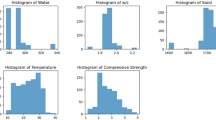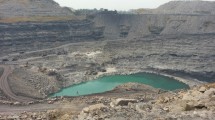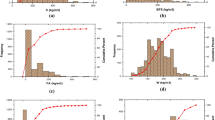Abstract
Uniaxial compressive strength (UCS) value of a rock material is one of the most important design parameters in engineering practice and related fields of geosciences. Through this importance, prediction of UCS values of rock materials from nondestructive quicker and simpler tests are widely preferred. The aim of this study is to predict the UCS values of five carbonate rock groups including marble, dolomite, two limestones, and travertine from longitudinal ultrasonic wave velocity (Vp), Schmidt hardness rebound number (SHR), and cubic sample sizes (L). For this aim, a total of 90 cubic samples with 7, 9, and 11 cm edge sizes were prepared. Chemical, petrographical, and basic physical properties of the sample groups were investigated. After Vp and SHR values, UCS values of all samples were determined. By using multivariate regression analyses (MR), different UCS prediction equations from dry unit weight (γd), Vp, SHR, and also L values were proposed. Prediction performances of proposed model in which Vp, SHR, and L are input parameters was also analyzed by least square support vector machines (LS-SVM) method. Prediction performances of the MR and LS-SVM models were analyzed by coefficient of determination (R2), efficiency (E), and root mean square error (RMSE) performance measures. These values were calculated as 0.867, 0.799, and 16.616 respectively for the LS-SVM model and 0.781, 0.749, and 18.561 respectively for the MR model. The LS-SVM method was found to be successful in the prediction of the UCS values from nondestructive test data of carbonate rocks.










Similar content being viewed by others
References
Aboutaleb S, Bagherpour R, Behina M, Aghababaei M (2017) Combination of the physical and ultrasonic tests in estimating the uniaxial compressive strength and Young’s modulus of intact limestone rocks. Geotech Geol Eng 35:3015–3023
Altındağ R (2012) Correlation between P-wave velocity and some mechanical properties for sedimentary rocks. South Afr Inst Min Metall 112:229–237
Alvarez Grima M, Babuška R (1999) Fuzzy model for the prediction of unconfined compressive strength of rock samples. Int J Rock Mech Min 36:339–349
Anon (1979) Classification of rocks and soils for engineering geological mapping part I: rock and soil materials. Bull Int Assoc Eng Geol 19:364–371
ASTM (1999) Standard test method for compressive strength of dimension stone (designation: C 170). Annual book of ASTM standards, Philadelphia
Aydin A, Basu A (2005) The Schmidt hammer in rock material characterization. Eng Geol 81(1):1–14
Aydoğdu M, Fırat M (2015) Estimation of failure rate in water distribution network using fuzzy clustering and LS-SVM methods. Water Resour Manag 29:1575–1590
Azimian A (2017) Application of statistical methods for predicting uniaxial compressive strength of limestone rocks using nondestructive tests. Acta Geotech 12:321–333
Baykasoğlu A, Güllü H, Çanakcı H, Özbakır L (2008) Prediction of compressive and tensile strength of limestone via genetic programming. Expert Syst Appl 35:111–123
Beiki M, Majdi A, Givshad AD (2013) Application of genetic programming to predict the uniaxial compressive strength and elastic modulus of carbonate rocks. Int J Rock Mech Min 63:159–169
Bieniawski ZT (1974) Estimating the strength of rock materials. J S Afr I Min Metall 74(8):312–320
Bruno G, Vessia G, Bobbo L (2013) Statistical method for assessing the uniaxial compressive strength of carbonate rock by Schmidt hammer tests performed on core samples. Rock Mech Rock Eng 46:199–206
Büyüksağış İS, Göktan RM (2007) The effect of Schmidt hammer type on uniaxial compressive strength prediction of rock. Int J Rock Mech Min 44:299–307
Cargill JS, Shakoor A (1990) Evaluation of empirical methods for measuring the uniaxial compressive strength of rock. Int J Rock Mech Min Sci Geomech Abstr 27(6):495–503
Çelik SB (2017) The effect of cubic specimen size on uniaxial compressive strength of carbonate rocks from Western Turkey. Arab J Geosci 10:426
Ceryan N, Okkan U, Kesimal A (2012) Application of generalized regression neural networks in predicting the unconfined compressive strength of carbonate rocks. Rock Mech Rock Eng 45:1055–1072
Ceryan N, Okkan U, Kesimal A (2013a) Prediction of unconfined compressive strength of carbonate rocks using artificial neural networks. Environ Earth Sci 68:807–819
Ceryan N, Okkan U, Samui P, Ceryan Ş (2013b) Modeling of tensile strength of rocks materials based on support vector machines approaches. Int J Numer Anal Methods Geomech 37:2655–2670
Çobanoğlu İ, Çelik SB (2008) Estimation of uniaxial compressive strength from point load strength, Schmidt hardness and P-wave velocity. Bull Eng Geol Environ 67:491–498
De Brabanter K, Karsmakers P, Ojeda F, Alzate C, De Brabanter J, Pelckmans K, De Moor B, Vandewalle J, Suykens JAK (2011) LS-SVMlab toolbox user’s guide version 1.8. K. U. Leuven, ESAT-SISTA TechnicalReport 10—146, Leuven, p 115
Deere DU, Miller RP (1966) Engineering classification of intact rock. Technical Report AFWL-TR-65-116. Kirtland Air Force Base, New Mexico 300p
Dehghan S, Sattarı GH, Chehreh CS, Aliabadi M (2010) Prediction of unconfined compressive strength and modulus of elasticity for travertine samples using regression and artificial neural networks. Min Sci Technol 20:41–46
Demirdağ S, Yavuz H, Altındağ R (2009) The effect of sample size on Schmidt rebound hardness value of rocks. Int J Rock Mech Min 46:725–730
Demirdağ S, Şengün N, Uğur İ, Altındağ R (2018) Estimating the uniaxial compressive strength of rocks with Schmidt rebound hardness by considering the sample size. Arab J Geosci 11:502
EN 1926 (2006) Natural stone test methods - Determination of uniaxial compressive strength. European Committee for Standardization, Brussels, p 17
EN 1936 (2006) Natural stone test methods - Determination of real density and apparent density, and of total and open porosity. European Committee for Standardization, Brussels, p 10
Entwisle DC, Hobbs PRN, Jones LD, Gunn D, Raines MG (2005) The relationships between effective porosity, uniaxial compressive strength and sonic velocity of intact Borrowdale Volcanic Group core samples from Sellafield. Geotech Geol Eng 23:793–809
Ersoy H, Kanık D (2012) Multicriteria decision-making analysis based methodology for predicting carbonate rocks’ uniaxial compressive strength. Earth Sci Res J 16(1):65–74
Fener M, Kahraman S, Bilgil A, Günaydın O (2005) A comparative evaluation of indirect methods to estimate the compressive strength of rocks. Rock Mech Rock Eng 38(4):329–343
Gökçeoğlu C (1996) An assessment on the reliability of uniaxial compressive strength data estimated from Schmidt hammer hardness rebounds. Geol Eng 48:78–81 (In Turkish)
Gökçeoğlu C (2002) A fuzzy triangular chart to predict the uniaxial compressive strength of the Ankara agglomerates from their petrographic composition. Eng Geol 66:39–51
Goyal MK, Bharti B, Quilty J, Adamowski J, Pandey A (2014) Modeling of daily pan evaporation in sub tropical climates using ANN, LS-SVR, fuzzy logic, and ANFIS. Expert Syst Appl 41:5267–5276
Gupta V, Sharma R, Sah MP (2009) An evaluation of surface hardness of natural and modified rocks using Schmidt hammer: study from northwestern Himalaya, India. Geogr Ann 91 A(3):179–188
Hebib R, Belhai D, Alloul B (2017) Estimation of uniaxial compressive strength of North Algeria sedimentary rocks using density, porosity, and Schmidt hardness. Arab J Geosci 10:383
Hucka V (1965) A rapid method of determining the strength of rocks in situ. Int J Rock Mech Min 2:127–134
ISRM (2007) The complete ISRM suggested methods for rock characterization, testing and monitoring: 1974–2006. In: Ulusay R, Hudson JA (eds) suggested methods prepared by the commission on testing methods. ISRM, Compilation arranged by the ISRM Turkish National Group, Ankara 628p
Jun X, Annan J, Zhiwu W, Jingping Q (2013) A nonlinear optimization technique of tunnel construction based on DE and LSSVM. Math Probl Eng 2013(980154):11
Kahraman S (2001) Evaluation of simple methods for assessing the uniaxial compressive strength of rock. Int J Rock Mech Min 38:981–994
Kahraman S (2007) The correlations between the saturated and dry P-wave velocity of rocks. Ultrasonics 46:341–348
Kahraman S, Alber M (2006) Estimating unconfined compressive strength and elastic modulus of a fault breccia mixture of weak blocks and strong matrix. Int J Rock Mech Min 43:1277–1128
Karakul H (2017) Investigation of saturation effect on the relationship between compressive strength and Schmidt hammer rebound. Bull Eng Geol Environ 76:1143–1152
Karakul H, Ulusay R (2013) Empirical correlations for predicting strength properties of rocks from P-wave velocity under different degrees of saturation. Rock Mech Rock Eng 46:981–999
Karakuş M, Kumral M, Kılıç O (2005) Predicting elastic properties of intact rocks from index tests using multiple regression modelling. Int J Rock Mech Min 42:323–330
Karaman K, Kesimal A (2015) A comparative study of Schmidt hammer test methods for estimating the uniaxial compressive strength of rocks. B Eng Geol Environ 74:507–520
Katz O, Reches Z, Roegiers J-C (2000) Evaluation of mechanical rock properties using a Schmidt hammer. Int J Rock Mech Min 37:723–728
Kılıç A, Teymen A (2008) Determination of mechanical properties of rocks using simple methods. B Eng Geol Environ 67:237–244
Kurtuluş C, Sertçelik F, Sertçelik I (2016) Correlating physico-mechanical properties of intact rocks with P-wave velocity. Acta Geodyn Geophys 51:571–582
Madhubabu N, Singh PK, Kainthola A, Mahanta B, Tripathy A, Singh TN (2016) Prediction of compressive strength and elastic modulus of carbonate rocks. Measurement 88:202–213
Minaeian B, Ahangari K (2013) Estimation of uniaxial compressive strength based on P-wave and Schmidt hammer rebound using statistical method. Arab J Geosci 6:1925–1931
Mishra DA, Basu A (2013) Estimation of uniaxial compressive strength of rock materials by index tests using regression analysis and fuzzy inference system. Eng Geol 160:54–68
Mishra DA, Srigyan M, Basu A, Rokade PJ (2015) Soft computing methods for estimating the uniaxial compressive strength of intact rock from index tests. Int J Rock Mech Min 80:418–424
Momeni E, Nazir R, Armaghani DJ, Mohamad ET (2015) Prediction of unconfined compressive strength of rocks: a review paper. J Teknol 77(11):43–50
O’Rourke JE (1989) Rock index properties for geoengineering in underground development. Min Eng 41(2):106–110
Palchik V, Hatzor YH (2004) The influence of porosity on tensile and compressive strength of porous chalk. Rock Mech Rock Eng 37(4):331–341
Parent T, Domede N, Sellier A, Mouatt L (2015) Mechanical characterization of limestone from sound velocity measurement. Int J Rock Mech Min 79:149–156
Proceq (2014) Pundit lab/Pundit lab+ ultrasonic instrument operating instructions. Proceq SA, Zurich, p 31
Proceq (2016) Portable nondestructive concrete testing instrument. Proceq SA, Zurich, p 10
Sachpazis CI (1990) Correlating Schmidt hardness with compressive strength and Young’s modulus of carbonate rocks. Bull Int Assoc Eng Geol 42(1):75–83
Samsudin R, Saad P, Shabri A (2011) River flow time series using least squares support vector machines. Hydrol Earth Syst Sc 15(6):1835–1852
Sarkar K, Tiwary A, Singh TN (2010) Estimation of strength parameters of rock using artificial neural networks. B Eng Geol Environ 69(4):599–606
Schmidt E (1951) Investigations with the new concrete test hammer for estimating the quality of concrete. Schweizer Archive angerwandte Wissenschaft Technik (Solothurn) 17(5):139
Selçuk L, Nar A (2015) Prediction of uniaxial compressive strength of intact rocks using ultrasonic pulse velocity and rebound-hammer number. Q J Eng Geol Hydrogeol 49(1):67–75
Selçuk L, Yabalak E (2015) Evaluation of the ratio between uniaxial compressive strength and Schmidt hammer rebound number and its effectiveness in predicting rock strength. Nondestruct Test Eva 30(1):1–12
Shabri A, Suhartono (2012) Streamflow forecasting using least-squares support vector machines. Hydrol Sci J 57(7):1275–1293
Shalabi FI, Cording EJ, Al-Hattamleh OH (2007) Estimation of rock engineering properties using hardness tests. Eng Geol 90(3):138–147
Sharma PK, Singh TN (2008) A correlation between P-wave velocity, impact strength index, slake durability index and uniaxial compressive strength. B Eng Geol Environ 67(1):17–22
Sharma PK, Khandelwal M, Singh TN (2011) A correlation between Schmidt hammer rebound numbers with impact strength index, slake durability index and P-wave velocity. Int J Earth Sci 100(1):189–195
Sönmez H, Tuncay E, Gökçeoğlu C (2004) Models to predict the uniaxial compressive strength and the modulus of elasticity for Ankara agglomerate. Int J Rock Mech Min 41(5):717–729
Sönmez H, Gökçeoğlu C, Nefeslioğlu HA, Kayabaşı A (2006) Estimation of rock modulus: for intact rocks with an artificial neural network and for rock masses with a new empirical equation. Int J Rock Mech Min 43(2):224–235
Suykens JAK, Vandewalle J (1999) Least squares support vector machine classifiers. Neural Process Lett 9(3):293–300
Suykens JAK, Van Gestel T, De Brabanter J, De Moor B, Vandewalle J (2002) Least squares support vector machines. World Scientific, Singapore 294p
Tiryaki B (2008) Predicting intact rock strength for mechanical excavation using multivariate statistics, artificial neural networks and regression trees. Eng Geol 99(1–2):51–60
Tütmez B, Tercan AE (2007) Spatial estimation of some mechanical properties of rocks by fuzzy modelling. Comput Geotech 34(1):10–18
Vasanelli E, Calia A, Colangiuli D, Micelli F, Aiello MA (2016) Assessing the reliability of non-destructive and moderately invasive techniques for the evaluation of uniaxial compressive strength of stone masonry units. Constr Build Mater 124:575–581
Viswanathan R, Samui P (2016) Determination of rock depth using artificial intelligence techniques. Geosci Front 7(1):61–66
Yağız S (2009) Predicting uniaxial compressive strength, modulus of elasticity and index properties of rocks using the Schmidt hammer. B Eng Geol Environ 68(1):55–63
Yağız S, Sezer EA, Gökçeoğlu C (2012) Artificial neural networks and nonlinear regression techniques to assess the influence of slake durability cycles on the prediction of uniaxial compressive strength and modulus of elasticity for carbonate rocks. Int J Numer Anal Methods Geomech 36(14):1636–1650
Yaşar E, Erdoğan E (2004a) Correlating sound velocity with the density, compressive strength and Young’s modulus of carbonate rocks. Int J Rock Mech Min 41:871–875
Yaşar E, Erdoğan Y (2004b) Estimation of rock physicomechanical properties using hardness methods. Eng Geol 71(3):281–288
Yılmaz I, Sendir H (2002) Correlation of Schmidt hardness with unconfined compressive strength and Young’s modulus in gypsum from Sivas (Turkey). Eng Geol 66(3):211–219
Yılmaz I, Yüksek AG (2008) An example of artificial neural network (ANN) application for indirect estimation of rock parameters. Rock Mech Rock Eng 41(5):781–795
Yılmaz I, Yüksek G (2009) Prediction of the strength and elasticity modulus of gypsum using multiple regression, ANN, and ANFIS models. Int J Rock Mech Min 46(4):803–810
Zhu C, Zhao H, Zhao M (2014) Back analysis of geomechanical parameters in underground engineering using artificial bee colony. Sci World J 2014(693812):13
Zhu C, Zhao H, Ru Z (2015) LSSVM-based rock failure criterion and its application in numerical simulation. Math Probl Eng 2015(246068):13
Acknowledgements
The author wishes to express his sincere gratitude to geological engineers Ozan Düdükçü and Emin Deymeci from Ece and Çoban Marble Companies in Denizli, Turkey, respectively, for their support in sample supply and preparation. The author also wishes to express his kind regards to Dr. Fatih Dikbaş for English language editing of the manuscript.
Author information
Authors and Affiliations
Corresponding author
Additional information
Editorial handling: Ali Karrech
Rights and permissions
About this article
Cite this article
Çelik, S.B. Prediction of uniaxial compressive strength of carbonate rocks from nondestructive tests using multivariate regression and LS-SVM methods. Arab J Geosci 12, 193 (2019). https://doi.org/10.1007/s12517-019-4307-2
Received:
Accepted:
Published:
DOI: https://doi.org/10.1007/s12517-019-4307-2




